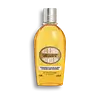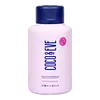What's inside
What's inside
 Key Ingredients
Key Ingredients

 Benefits
Benefits

 Concerns
Concerns

 Ingredients Side-by-side
Ingredients Side-by-side

Vitis Vinifera Seed Oil
EmollientTipa-Laureth Sulfate
CleansingLaureth-3
EmulsifyingCaprylic/Capric Triglyceride
MaskingParfum
MaskingCocamide Mea
EmulsifyingPropylene Glycol
HumectantSorbitan Oleate
EmulsifyingPrunus Amygdalus Dulcis Oil
Skin ConditioningCitrus Aurantium Bergamia Fruit Oil
MaskingHelianthus Annuus Seed Oil
EmollientRosmarinus Officinalis Leaf Extract
AntimicrobialTocopherol
AntioxidantWater
Skin ConditioningLimonene
PerfumingCoumarin
PerfumingLinalool
PerfumingVitis Vinifera Seed Oil, Tipa-Laureth Sulfate, Laureth-3, Caprylic/Capric Triglyceride, Parfum, Cocamide Mea, Propylene Glycol, Sorbitan Oleate, Prunus Amygdalus Dulcis Oil, Citrus Aurantium Bergamia Fruit Oil, Helianthus Annuus Seed Oil, Rosmarinus Officinalis Leaf Extract, Tocopherol, Water, Limonene, Coumarin, Linalool
Water
Skin ConditioningAloe Barbadensis Leaf Juice
Skin ConditioningSodium C14-16 Olefin Sulfonate
CleansingCocamidopropyl Betaine
CleansingSodium Cocoyl Isethionate
CleansingGlycerin
HumectantStearic Acid
CleansingParfum
MaskingBenzyl Alcohol
PerfumingAcrylates Crosspolymer-4
Emulsion StabilisingGlycol Distearate
EmollientCocos Nucifera Water
MaskingCoconut Oil Glycereth-8 Esters
CleansingGlycol Stearate
EmollientInulin
Skin ConditioningSodium Lauroyl Sarcosinate
CleansingPotassium Sorbate
PreservativeCoconut Flower Sugar
AntioxidantSodium Hydroxide
BufferingTrisodium Ethylenediamine Disuccinate
Alpha-Glucan Oligosaccharide
CleansingButeth-3
SolventCitric Acid
BufferingSodium Benzotriazolyl Butylphenol Sulfonate
UV AbsorberTributyl Citrate
SolventHylocereus Undatus Fruit Extract
Skin ConditioningPsidium Guajava Fruit Extract
AstringentSodium Benzoate
MaskingCarica Papaya Fruit Extract
Skin ConditioningCocos Nucifera Fruit Extract
EmollientFicus Carica Fruit Extract
HumectantGarcinia Mangostana Fruit Extract
Skin ConditioningMangifera Indica Fruit Extract
Skin ConditioningTheobroma Cacao Seed Extract
AntioxidantCI 17200
Cosmetic ColorantWater, Aloe Barbadensis Leaf Juice, Sodium C14-16 Olefin Sulfonate, Cocamidopropyl Betaine, Sodium Cocoyl Isethionate, Glycerin, Stearic Acid, Parfum, Benzyl Alcohol, Acrylates Crosspolymer-4, Glycol Distearate, Cocos Nucifera Water, Coconut Oil Glycereth-8 Esters, Glycol Stearate, Inulin, Sodium Lauroyl Sarcosinate, Potassium Sorbate, Coconut Flower Sugar, Sodium Hydroxide, Trisodium Ethylenediamine Disuccinate, Alpha-Glucan Oligosaccharide, Buteth-3, Citric Acid, Sodium Benzotriazolyl Butylphenol Sulfonate, Tributyl Citrate, Hylocereus Undatus Fruit Extract, Psidium Guajava Fruit Extract, Sodium Benzoate, Carica Papaya Fruit Extract, Cocos Nucifera Fruit Extract, Ficus Carica Fruit Extract, Garcinia Mangostana Fruit Extract, Mangifera Indica Fruit Extract, Theobroma Cacao Seed Extract, CI 17200
 Reviews
Reviews

Ingredients Explained
These ingredients are found in both products.
Ingredients higher up in an ingredient list are typically present in a larger amount.
Parfum is a catch-all term for an ingredient or more that is used to give a scent to products.
Also called "fragrance", this ingredient can be a blend of hundreds of chemicals or plant oils. This means every product with "fragrance" or "parfum" in the ingredients list is a different mixture.
For instance, Habanolide is a proprietary trade name for a specific aroma chemical. When used as a fragrance ingredient in cosmetics, most aroma chemicals fall under the broad labeling category of “FRAGRANCE” or “PARFUM” according to EU and US regulations.
The term 'parfum' or 'fragrance' is not regulated in many countries. In many cases, it is up to the brand to define this term.
For instance, many brands choose to label themselves as "fragrance-free" because they are not using synthetic fragrances. However, their products may still contain ingredients such as essential oils that are considered a fragrance by INCI standards.
One example is Calendula flower extract. Calendula is an essential oil that still imparts a scent or 'fragrance'.
Depending on the blend, the ingredients in the mixture can cause allergies and sensitivities on the skin. Some ingredients that are known EU allergens include linalool and citronellol.
Parfum can also be used to mask or cover an unpleasant scent.
The bottom line is: not all fragrances/parfum/ingredients are created equally. If you are worried about fragrances, we recommend taking a closer look at an ingredient. And of course, we always recommend speaking with a professional.
Learn more about ParfumWater. It's the most common cosmetic ingredient of all. You'll usually see it at the top of ingredient lists, meaning that it makes up the largest part of the product.
So why is it so popular? Water most often acts as a solvent - this means that it helps dissolve other ingredients into the formulation.
You'll also recognize water as that liquid we all need to stay alive. If you see this, drink a glass of water. Stay hydrated!
Learn more about Water